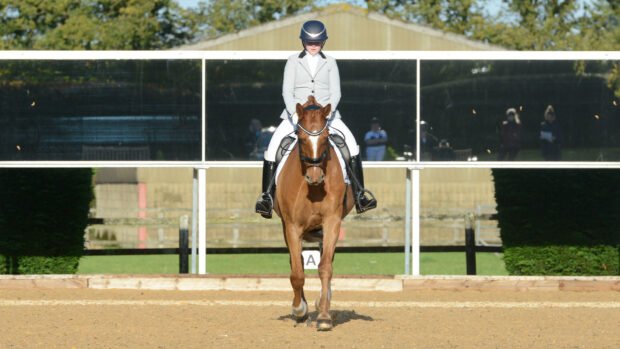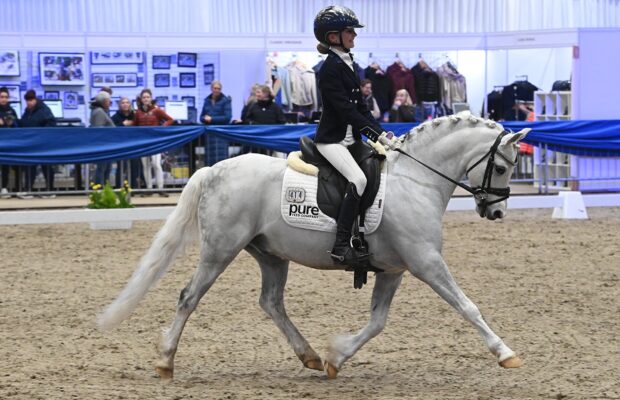Travers, or quarters-in, is a form of lateral work for horses in which the horse’s quarters are brought in off the track while the shoulders remain on it. The horse is bent uniformly from poll to tail around the rider’s inside leg, while looking in the direction of travel. It is the first lateral movement where the horse is moving in the same direction as it is looking. Learning how to ride travers correctly will increase your skills as a rider and also improve your horse’s suppleness and ability to collect.
When introducing lateral movements, horse and rider should start with leg yield, then progress to shoulder-in, travers, renvers, and finally, half pass.
In travers the horse’s outside legs pass and cross in front of the inside legs, to give three or four lines of footprints. It can be done along a wall or up the centre line, but you should be ultimately aiming for an angle of about 30 degrees to the line of your track.
Benefits of learning how to ride travers to the rider
- Develops co-ordination
- Teaches the rider how to control the haunches and hind legs
- Is a useful preparation for half-pass
Benefits of travers to the horse
- Improves co-ordination, suppleness and athleticism
- Encourages engagement of the hocks, especially the inside hind leg
- Develops collection
- Increases obedience to the rider’s aids
- Preparation for half-pass
How to ride travers: the correct aids

In travers the horse’s quarters are brought in off the track while the shoulders remain on it
- Inside rein opens a little to indicate bend/ask for flexion
- Outside rein is kept close to the neck, controlling the energy, guarding against excess bend, and keeping the shoulders on the track
- Inside leg used on the girth to ask for bend and to generate impulsion
- Outside leg used behind the girth to move the hindquarters over
- The rider should place a little more weight on the inside seat bone and keep their shoulders parallel to those of the horse, ie facing the direction of travel
- The aids for travers and renvers are the same – all that varies is the initial positioning of the horse.
How to start
Warm up with a few transitions and plenty of circles. Then, if your horse is going well, ask for some leg yield before progressing to shoulder-in in walk and trot to encourage greater collection.
Go back to walk and ride a few shoulder-ins down the long side, starting and finishing each long side with a 10m circle. Then, at the beginning of your next long side, set up the bend as you ride around the short end, as if you were going to ride another 10m circle. As you come out of the corner, once your horse’s nose is level with the track, apply the aids to ask the hindquarters to step in on an inner track. It may help to carry your schooling stick in the outside hand.
You should aim to maintain the energy level without losing rhythm or balance, so frequent half-halts will be required. This is quite a strenuous movement for a horse that is not used to it so go for quality rather than quantity. If your horse shows you a few good strides, straighten him by moving the quarters back in line with the shoulders. This reinforces the idea of moving that part of the body first in one direction and then returning it. Ride forwards positively out of the movement and reward your horse.
What can go wrong?
Excessive head and neck bend in travers, or the wrong bend altogether, is usually a result of poor riding. Go back a step by working on your leg yield and shoulder-in while checking you are maintaining the correct riding position before trying again.
If your horse is showing not enough or too much angle, use a mirror or a knowledgeable assistant on the ground to help you find the correct angle.
Sideways rather than forwards movement may be due to lack of impulsion. The rider needs to encourage the horse to step forwards with more energy before trying to movement again.
A loss of rhythm or balance can occur because not enough half-halts are being used. This will lead to a loss of quality in the pace. Frequent half-halts are essential for any lateral work.
If your horse panics, throws his head in the air and hollows, he is showing he does not understand what you want, so you need to go back a few steps and make sure you understand and are giving the correct aids. Aim to keep your horse in a correct soft outline throughout the exercises.
If the horse is rushing or not showing enough collection, return to shoulder-in to encourage the horse’s outline to shorten and the hindquarters to engage.
Whatever the problem, the first step to fix it is to straighten your horse and ride on positively. Try to establish why the movement went wrong and address that before asking again. Most problems are caused by insufficient preparation, leading to a lack of understanding or confusion on the horse’s part.
Common rider’s position faults to look out
- Collapsing hip
- Not sitting straight
- Tension and stiffness
- Drawing legs up and back
Travers can be ridden in walk, trot or canter, but as most horses will choose to travel slightly quarters-in in canter, it should only be introduced in that pace once a true straight canter has been established as the normal way of going for the horse.
Is travers found in dressage tests?
Travers can be found in medium level tests under British Dressage rules, and at intermediate and above in British Eventing.
You might also be interested in:

What is shoulder-in, and how can it help my horse?
Shoulder-in is a useful exercise to increase suppleness in the horse. Here we look at the aids, common problems and

How to nail the perfect half pass for training and competition
The preparation for the perfect half pass

Subscribe to Horse & Hound magazine today – and enjoy unlimited website access all year round
Horse & Hound magazine, out every Thursday, is packed with all the latest news and reports, as well as interviews, specials, nostalgia, vet and training advice. Find how you can enjoy the magazine delivered to your door every week, plus options to upgrade your subscription to access our online service that brings you breaking news and reports as well as other benefits.




